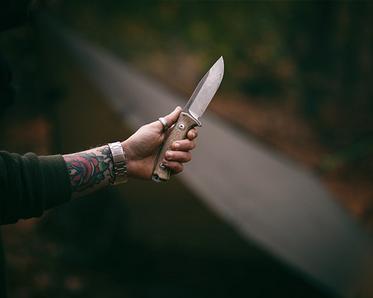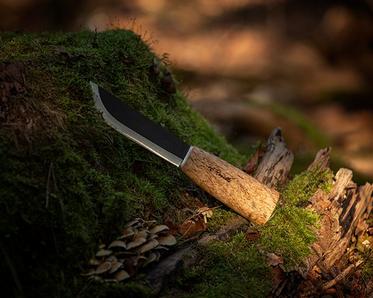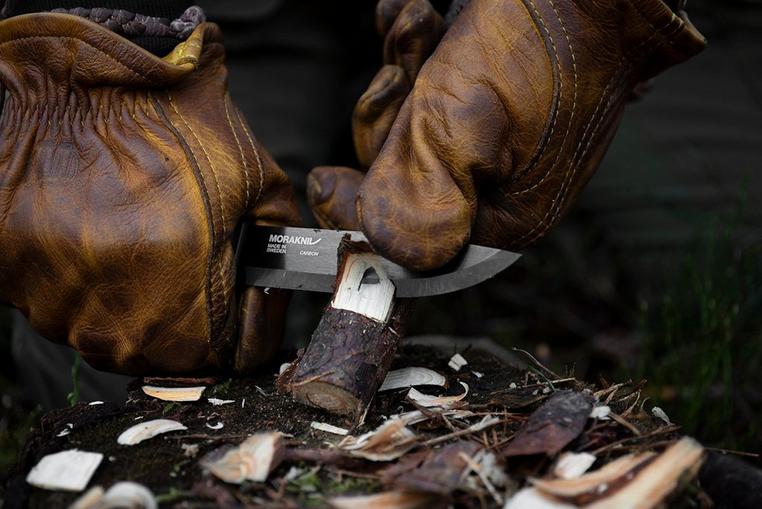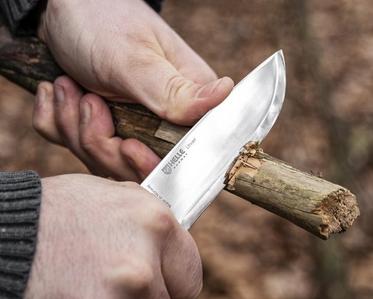Survival knives vs bushcraft knives
Survival knives vs bushcraft knives: two popular types of outdoor knives, but what are the differences? And what do they have in common? We've laid them out, side by side, and will do our best to show you the distinguishing features of both types.
Disclaimer
First things first, a disclaimer. Bushcraft and survival are closely related, and some people use the terms interchangeably. For this reason, our article will be based on our own perspective on these two outdoor activities. Beyond that, there are many differing opinions about bushcraft knives and survival knives. We choose to share our point of view here as well, which is mainly based on the thousands of customers who have allowed us to help them make these choices over the years.
The main difference
There are two main differences between bushcraft knives and survival knives: the difference in blade length and the difference in design. In general, survival knives have longer and broader blades. This means they can take a beating, and they're better for heavier tasks such as batoning. The larger blade is what gives survival knives their tactical appearance. The blades of bushcraft knives are generally a bit smaller, and often have a scandi edge. This is what makes bushcraft knives perfect for eviscerating small game and woodwork. As such, bushcrafts knives have a classic and minimalistic appearance.
In this article, you will read more about the differences between bushcraft knives and survival knives.
Survival vs Bushcraft
You can't compare the two types of knives without comparing the two different activities. In essence, bushcraft is about intentionally living in nature. You choose to venture into the woods, and if there is anything you need to feel comfortable there, you create it yourself. It is a pastime. Practically speaking, this means camping trips and day trips into the forest, not emergency situations.
Survival, on the other hand, is about (you guessed it!) surviving in nature, and about getting out of the woods as quickly as possible. There's no room for comfort, and the things you have with you need to be foolproof and functional. In practice, we're talking about soldiers and survival enthusiasts who get dropped off in a forest with minimal resources, as a test of their endurance. This can also be done for fun, but the approach is clearly different from bushcraft.
The strength of an outdoor knife
One of the most important criteria for a survival knife is its strength. In a survival situation, you need to be able to rely on your knife. To put it even more bluntly: a knife that fails could cost you your life. This is less of an issue in a bushcraft setting. What this means is that a survival knife needs to be really robust.
For instance, the thickness of the blade has to be sufficient, or at least in proportion to the length of the knife. A compact survival knife works great with a somewhat thinner blade, but with a longer knife, you'll be more inclined to use it more heavily, so the chance of damaging it increases exponentially. Don't forget that a knife is not an axe, no matter how impressive those YouTube videos of people whittling gigantic blocks of wood may be.
We advise against a wooden handle, because wood can split or warp. Yes, this can be solved with stabilised wood, but if your life depends on it, there are better handle materials to choose from. We prefer to use G10, micarta or a strong fibre-reinforced plastic.
Of course, this doesn't mean that a bushcraft knife will just break whenever a light breeze rolls in. It is simply a trade-off between what you can do with a knife, and what the knife can handle. For example, a slightly thinner blade is a lot better suited to cutting fruit and vegetables. And under normal circumstances, a wooden handle holds up really well. You just want to prevent the knife from suddenly becoming totally useless after getting dropped on a rock.
Woodcraft
One of the key elements of bushcraft is woodcraft. Woodcraft involves working wood to make tools and equipment that will make your time outdoors more enjoyable. One great example is a pot hanger. This is a handy contraption that allows you to hang a kettle or pan over an open fire. You can also cut your own tent pegs, or make a roycroft pack frame as a rucksack. While carving wood, you'll notice that a finer bushcraft knife is easier to use than a thicker and more robust survival knife. Also, the average bushcrafter will often opt for a knife with a scandi grind or a convex grind, because these knives are highly suited to woodworking.
Of course, you can also work wood with a survival knife, which will usually have a flat grind. And there are also plenty of flat grind bushcraft knives.
Ergonomics of outdoor knives
There are also differences in terms of ergonomics. For a survival knife, grip is extremely important. Under no circumstances do you want to end up injuring yourself because of the knife's design. A bushcraft knife is more focused on ergonomics. After all, if you are carving your camping equipment out of wood yourself, you're going to be at it for a while, so the last thing you want is to have blisters on your hands after fifteen minutes.
Steel for a bushcraft knife or survival knife
One of the similarities between the two types of knives is the steel. You'll find little difference between them. In both categories, you'll find a significant number of carbon steel knives. In the survival corner, this is due to carbon steel's strength and the fact that it can be sharpened with minimal resources. Bushcraft enthusiasts also appreciate that it can be easily sharpened, but more out of convenience rather than necessity.
A tool steel or carbon steel knife survival knife is also slightly tougher and more bendable than stainless steel. After all, in a critical situation you will always want the knife to bend rather than break. The fact that carbon steel isn't entirely stainless is only a small price to pay, as long as you know that your knife can handle whatever you throw at it. The best-known example of this is 1095 carbon steel, which is used by many manufacturers. But CPM 3V is also extremely tough, and still with slightly more corrosion resistance.
Size of the knife
Earlier in this article, we already gave a number of examples where the user's personal preference plays a major role. But on the question of knife size, this becomes fully apparent.
However, there are some generalisations we can make when it comes to bushcraft knives. The most popular bushcraft knives have a blade length of between 9 and 13 centimetres. Most are between 10 and 11 centimetres long. This length is popular because it allows your hand to remain close to the tip, so you have lots of control, while a blade of roughly 10 centimetres also gives you enough length to do some whittling.
As for survival knives, there is more variance. Our most popular survival knives have a blade of 7 to 18 centimetres. Quite a wide range! The small sizes can be explained as neck knife-style survival knives that you carry as a backup. You use the larger knives for larger tasks, such as chopping thicker branches and trunks. It really comes down to what your preferences are, and where you carry the knife on you. You also have to take weight into consideration. Suppose you have to walk tens of kilometres to make your way back to civilisation. In that case, it will make a big difference whether your knife weighs 75 grams or 500 grams.
Blade shapes
In terms of blade shapes, the preferences are again very similar. Drop points dominate, simply because this is the most popular blade shape for all pocket knives and outdoor knives. And with good reason. An average drop point blade has all the shapes and features you're looking for in a knife: a sharp tip, a ‘belly’ in the edge and a straight section.
After drop points, we also see a lot of clip points, mainly in the survival arena. The clip point was originally a blade shape commonly used in hunting. But it is also often seen on more tactical-looking knives. That is why you regularly see it in survival knives: there is a great deal of overlap with military knives. There are often no real advantages or disadvantages compared to a drop point. You could say that some clip points have a slightly sharper or thinner point, which is great for precision tasks.
On the survival side, you can also see other blade shapes besides these two types. These include tanto, kukri and sheepsfoot. These exceptions are less common among bushcraft knives.
Sheaths for outdoor knives
Finally, we'd like to talk about sheaths. For bushcraft, you can actually choose whatever material you want; it's all good. Generally, leather is preferred, because it is a more natural material. But it's certainly not a necessity.
In a survival setting, things are slightly different. Good resistance to the elements and excellent retention are essential here. After all, you want to ensure that a heavy rain shower or a slide along the rocks won't cause your leather sheath to tear. That's why many people prefer kydex or plastic for their survival knife. The excellent retention they offer is necessary because losing your knife is not an option here. A firm hold in the sheath, or an extra strap, is priceless. If you'd like to find out more about sheaths, we have more information about knife sheaths here.
Survival knives versus/and bushcraft knives
In conclusion, we would like to emphasise once again that there are many knives that are suitable for both purposes. There are also plenty of knives that may have been specifically designed for bushcraft but that also meet all the requirements of a survival knife, and vice versa. Apart from that, personal preference plays a big role. Some people swear by a scandi grind on a survival knife, even though that is actually a typical feature of bushcraft knives. By the same token, there are bushcrafters who like using a thicker and more robust knife for chopping, even though many bushcraft enthusiasts would prefer an axe for that task.
Therefore, our advice is: try and test for yourself. Even in the lower segment, you'll find many specific outdoor knives that will enable you to try out something different for a relatively low investment. And you're sure to learn something valuable in the process.






?%24center=center&%24poi=poi&%24product-image%24=&fmt=auto&h=500&poi=%7B%24this.metadata.pointOfInterest.x%7D%2C%7B%24this.metadata.pointOfInterest.y%7D%2C%7B%24this.metadata.pointOfInterest.w%7D%2C%7B%24this.metadata.pointOfInterest.h%7D&scaleFit=%7B%28%24this.metadata.pointOfInterest%29%3F%24poi%3A%24center%7D&sm=c&w=1208)
?%24center=center&%24poi=poi&%24product-image%24=&fmt=auto&h=500&poi=%7B%24this.metadata.pointOfInterest.x%7D%2C%7B%24this.metadata.pointOfInterest.y%7D%2C%7B%24this.metadata.pointOfInterest.w%7D%2C%7B%24this.metadata.pointOfInterest.h%7D&scaleFit=%7B%28%24this.metadata.pointOfInterest%29%3F%24poi%3A%24center%7D&sm=c&w=1208)





?%24center=center&%24poi=poi&%24product-image%24=&fmt=auto&h=500&poi=%7B%24this.metadata.pointOfInterest.x%7D%2C%7B%24this.metadata.pointOfInterest.y%7D%2C%7B%24this.metadata.pointOfInterest.w%7D%2C%7B%24this.metadata.pointOfInterest.h%7D&scaleFit=%7B%28%24this.metadata.pointOfInterest%29%3F%24poi%3A%24center%7D&sm=c&w=1208)
